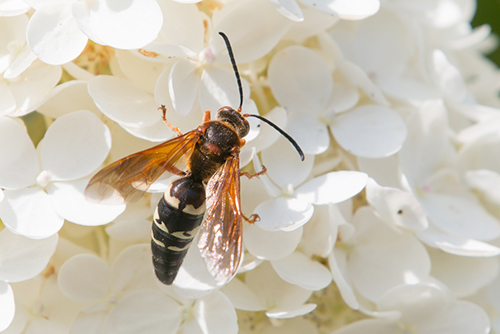
Have you ever seen a large black and yellow stripped flying insect and thought, what is that? Is that a gigantic yellow jacket? You're not the only one. Read more to learn all about cicada killers.
What Are Cicada Killers?
Cicada killers, also known as cicada hawks, eastern cicada killers, or sand hawks, are large wasps that look like yellow jackets. Despite their "killer" name, they are relatively harmless to anything other than insects, especially cicadas (smaller flying insects), which their larvae eat while growing into adults.
What Do Cicada Killers Look Like?

Measuring 0.5 to 2 inches long, cicada killers have black to reddish-brown heads and black to reddish-brown abdomens (rears) with yellow stripes, closely resembling yellow jackets. Their wings are also brown.
Female cicada killers are larger than males and have stingers used to paralyze cicadas. Male cicada killers do not have stingers.
Where Are Cicada Killers Found?

Female cicada killers are solitary and after mating, will dig holes and tunnels in which to lay their eggs. These tunnels can be 30-70 inches long and up to 15 inches below ground. Each tunnel will have several chambers.
Cicada killers will create their tunnels near bushes and trees where cicadas live for easy access. Their tunnels can be found in yards, next to sidewalks, in garden and flower beds, and in sandy areas like playgrounds and the sand traps of golf courses. The tunnels have small holes as entrances, often with dirt or sand in the shape of a U around the hole.
Preferable conditions for cicada killer tunnels are well-drained, light colored soil in full sunlight near cicadas.
Male cicada killers will hover near these tunnels and the bushes and trees where cicadas live in hopes to find a female to mate with. Males will group together and "fight" for dominance. When people encounter cicadas killers, they usually see the males.
Why Are They Called Cicada Killers?

Female cicada killers lay their eggs in the chambers of the tunnels they dig, usually one egg per chamber. They then catch and paralyze cicadas using their stingers and bring the paralyzed cicadas into the tunnels, leaving one in each chamber. When the eggs turn into larvae, they will eat the cicadas over the course of 10 days. About 40% of larvae grow into adult cicada killers thanks to this food.
Adult cicada killers only live for about 2-3 months, emerging from tunnels in late June or early July and dying by September or October. Adults feed on plant nectar and sap, but will prey on cicadas and other insects for their larvae.
Cicada killers are mostly harmless to people or pets, but there are rare occasions where a female cicada killer may be stepped on or bitten by a pet. In this instance, call a medical professional or veterinarian for advice.
How to Get Rid of Cicada Killers
Cicada killers like to make their tunnels in dry, well-drained soil. If you see evidence of a cicada killer tunnel, you can wet the hole of the tunnel and the surrounding soil with water. Churn the soil or sand to prevent future burrowing. The pests will leave and not return to wet soil that has been agitated.
Shop DoMyOwn's collection of cicada killer control products or give our customer service team a call at 866-581-7378 for advice. You can also email us at [email protected].


